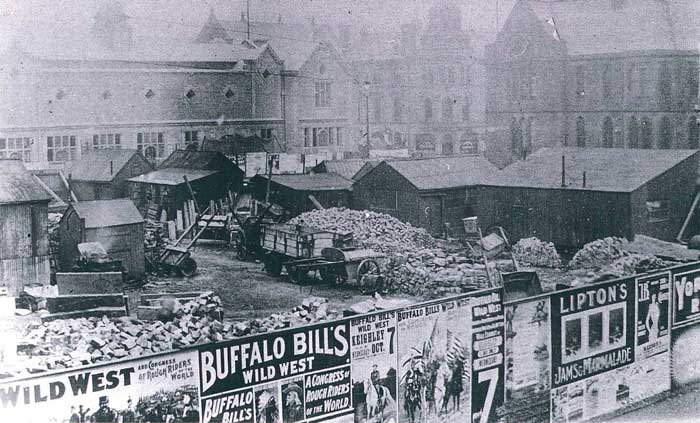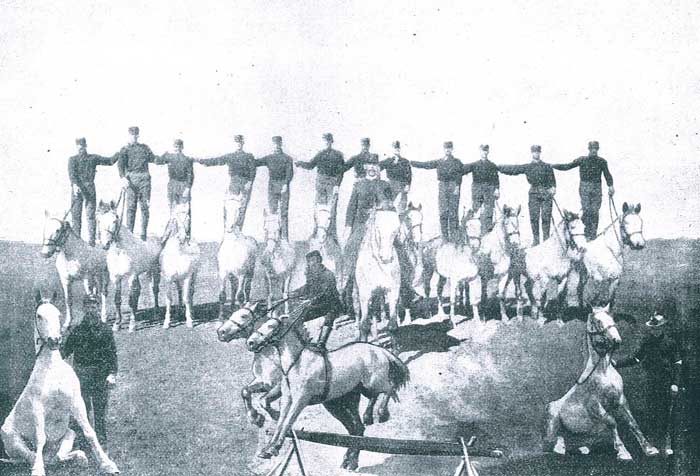
Buffalo Bill rides into Keighley: a look back to 1903
by Ian Dewhirst
One Day Only: Keighley, Wednesday, October 7, 1903: Grounds, Skipton Road: Buffalo Bill’s Wild West and Congress of Rough Riders of the World, Headed and Personally Introduced by Col. W. F. Cody, ‘Buffalo Bill’.”
Thus the advance publicity for Buffalo Bill’s ‘veritable Kindergarten of History – teaching facts, not on fiction founded,’ on a tour of England’s ‘principal cities and greater railway centres’ yet choosing to honour more modest Keighley with a visit, between a two-day stand at Bradford and one at Halifax.
The publicity, as Keighley’s great day approached, grew ever more fulsome, promising an exhibition of ‘Virile, Muscular, Heroic Manhood’ in the shape of ‘the Mounted Warriors of the World’ and ‘the Veteran Cavalry of many Flags’. As ‘the One Grand Ruler of the Amusement Realm, Standing like an obelisk above and beyond all others,’ the Wild West included English Lancers, Bedouin Arabs, South American Gauchos, United States Cavalry, Cuban Patriots, Russian Cossacks, Roosevelt’s Rough Riders, Mexican Rurales, and a hundred North American Indians from the Sioux, Brule, Arapahoe, Yankton, Cheyenne and Uncappappa tribes.
It offered ‘pictures of Border life’; a stagecoach ambush, a cattle roundup, bucking broncos, Indian war dances, an attack on a wagon train, and a ‘realistic military spectacle’ of the battle of San Juan Hill in the then-recent Spanish-American War of 1898.
It came in four special trains carrying 800 people and 500 horses, with covered stands to accommodate 14,000 spectators, and two electric light plants to illuminate a great open arena at night.

This atmospheric 1903 view of Keighley Corporation stone yard – site of the future Town Hall Square – includes posters advertising the visit of Buffalo Bill’s Wild West
Two performances were advertised, ‘rain or shine’, in the afternoon and evening, with admission prices ranging from a shilling to 7s.6d. (children half-price, except in the shilling seats). Tickets could be obtained from Archibald Ramsden’s Piano Saloon or at the grounds on the day, where, during the morning, Professor Sweeney’s 36- strong Famous Cowboy Band played classical and popular selections to encourage the doubtful.
Not untypically, the morning of October 7th was wet, and the grounds on the outskirts of town in fields that had accommodated Barnum and Bailey’s Greatest Show on Earth four years earlier were ploughed to mud during the setting up of the Wild West.
The performers’ procession from the railway was not looking its best, with the Indians huddled in blankets, each with a single feather drooping dejectedly on top of his head. But as the day developed the weather cleared and the crowds gathered.
They came in their thousands from the town, from the Worth Valley villages, from Skipton and beyond; 7,000 to the afternoon show and at least 10,000 at night. Keighley Corporation Tramways carried a record number of passengers that day, with six trams running continuously in addition to private omnibuses.
Less sophisticated audiences of 1903 must have marvelled at the show’s opening review of massed Rough Riders of the World. A souvenir booklet describes hundreds of horsemen ‘threading their way in and out past another, circling, halting, advancing, receding, reforming by fours and sixes, trailing out in single file, moving ribbons of men and horses spangled with gleaming metal.’
The local press admitted it was ‘a picturesque and stirring sight.’
But arguably the most dramatic moment was the entry of Cody himself, ‘reining-in a handsome black steed by means of a much-cherished silver-mounted bridle, the gift of the King when Prince of Wales.”
The most spectacular feature was the battle of San Juan Hill. The souvenir programme paints an aweinspiring picture of ‘the invading American forces.’ complete with mule pack train for ammunition, ‘massed in the forks of the trail at the foot of San Juan Hill’ defended by a blockhouse, trenches and rifle pits:
“From the fancied impregnability of their position, the superior Spanish force is seen pouring an incessant torrent of shrapnel and Mauser bullets into the exposed ranks.”
Actually San Juan Hill was made of canvas, the Spanish troops were the Indians in uniform, and the Americans stormed the position with ease, while their band played A Hot Time in the Old Town Tonight.

Troopers of the US Cavalry demonstrating their trick horsemanship
Audiences blissfully untutored in the realities of war were especially impressed by the Gatling machine gun which ‘added considerably to the effect.’
Yet it was a young butcher’s boy called Arthur Pakes, who had not even gone to the Wild West, who was given a special moment to remember. Later that evening he was running an errand for his mother in Keighley when a phaeton drawn by two cream horses stopped beside him and Buffalo Bill leaned out.
“Boy,” he said, “could you direct me to the Queen’s Theatre?”
Young Arthur could indeed, and while doing so took stock of Buffalo Bill’s fringed leather jacket, white sombrero, long flowing hair and beard, gold-rimmed spectacles and cigar.
“He looked a fine figure of a fellow,” he would repeat at intervals for the rest of his life.
At Keighley’s Queen’s Theatre that night, Walter Melville’s Renowned Company was performing an ‘enormously recommended’ London play, Her Second Time on Earth. Cody looked in towards the end, and the actors paused while their audience gave him a round of applause. It is not known what members of Walter Melville’s Renowned Company thought about being so upstaged.
Later research into the history of the American West has questioned the glamour of Buffalo Bill’s reputation as hunter, scout and Indian fighter, but there can be no denying his showmanship. The Keighley Herald of 1903 testifies to the sheer efficiency of his Wild West, commenting: “Within a couple of hours after the close of the evening performance the fields were practically cleared. The huge mass of baggage was conveyed in waggons to the Keighley Midland goods station and shortly after midnight the special trains conveying the array of performers, the horses and all the properties left for Halifax.”



